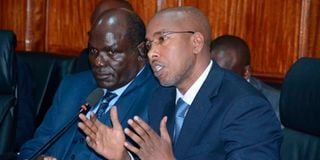IEBC shocker: Polling centres with no 3G coverage ‘unknown’

IEBC chairman Wafula Chebukati and chief executive Marjan Hussein in a past event.
The electoral commission does not know the number of polling centres that lack 3G network coverage, with just four months to the August 9 polls.
Although the Supreme Court nullified the August 8, 2017 presidential election on the basis of internet connectivity, the Independent Electoral and Boundaries Commission (IEBC) has done little to address the issue.
While appearing before the Justice and Legal Affairs Committee of the Senate yesterday, IEBC chairman Wafula Chebukati and chief executive Marjan Hussein could not provide statistics on the affected centres.
They did not know the number of stations that lack 3G internet coverage, only saying that the Communications Authority was still mapping the regions.
“Until the process is completed, we cannot give the actual statistics,” said Mr Chebukati.
Transmission of presidential results from polling stations to the national tallying centre is by law supposed to be done electronically.
This was a major sticking point in the 2017 elections as this was not proved to have been done in many cases due to lack of internet connectivity.
Shocked committee members warned the IEBC boss that he appeared to have learnt little from history, especially the 2017 election.
Makueni Senator Mutula Kilonzo Jnr challenged Mr Wabukati to take charge of the situation.
“Mr Chebukati does not appear to be confident about the election preparations. He doesn’t have many things at his fingertips,” Mr Kilonzo Jnr observed.
In the 2017 polls, 11,155 polling stations – some of them in Kiambu County – were outside the network, a puzzle that contributed to the nullification of the presidential poll.
Action of the regulator
Mr Marjan said the commission had shared the GPS coordinates of the 11,150 stations with CA, out of which only 456 were returned. He said the action of the regulator could mean that only 456 of the initial 11,150 are outside the network.
Also yet to be determined is the fate of the additional 2,800 centres used to register new voters that have been earmarked as new polling stations.
Out of these, the commission has shared the coordinates of 2,603 centres to the CA to determine if they fall within the network.
“We have not shared the coordinates of the remaining 197 centres because of insecurity,” Mr Marjan said, adding that most of them are in Northern Kenya.
“We are planning to procure security for our officers to travel to the affected regions to get the coordinates,” he added.
IEBC’s technical committee is working with CA to address the issue.
In annulling the August 2017 presidential election, the Supreme Court established that presiding officers did not transmit forms 34As to the national tallying centre electronically as the law requires.
If there’s no 3G network, presiding officers cannot move to any nearby place with network or the nearest polling station to declare the results since he will be committing an illegality.
Mr Marjan said the commission has phased out the BVR kits and opted for the Kenya Integrated Election Management Systems (Kiems) with three applications.
The kits can register, identify voters on the polling day and transmit results electronically.
“We have added a voter enrollment module so as to get rid of the BVR which has been in use since 2013 and had become obsolete,” he said.
The commission will also procure an additional 134,000 ballot boxes.
The number covers the boxes that have been worn out due to constant use since 2013 and those that have been broken.
IEBC and the Justice and Legal Affairs Committee of the National Assembly have generated the Elections (Amendment) Bill, 2022, which seeks to fix the major issues that were cited by the Supreme Court.





